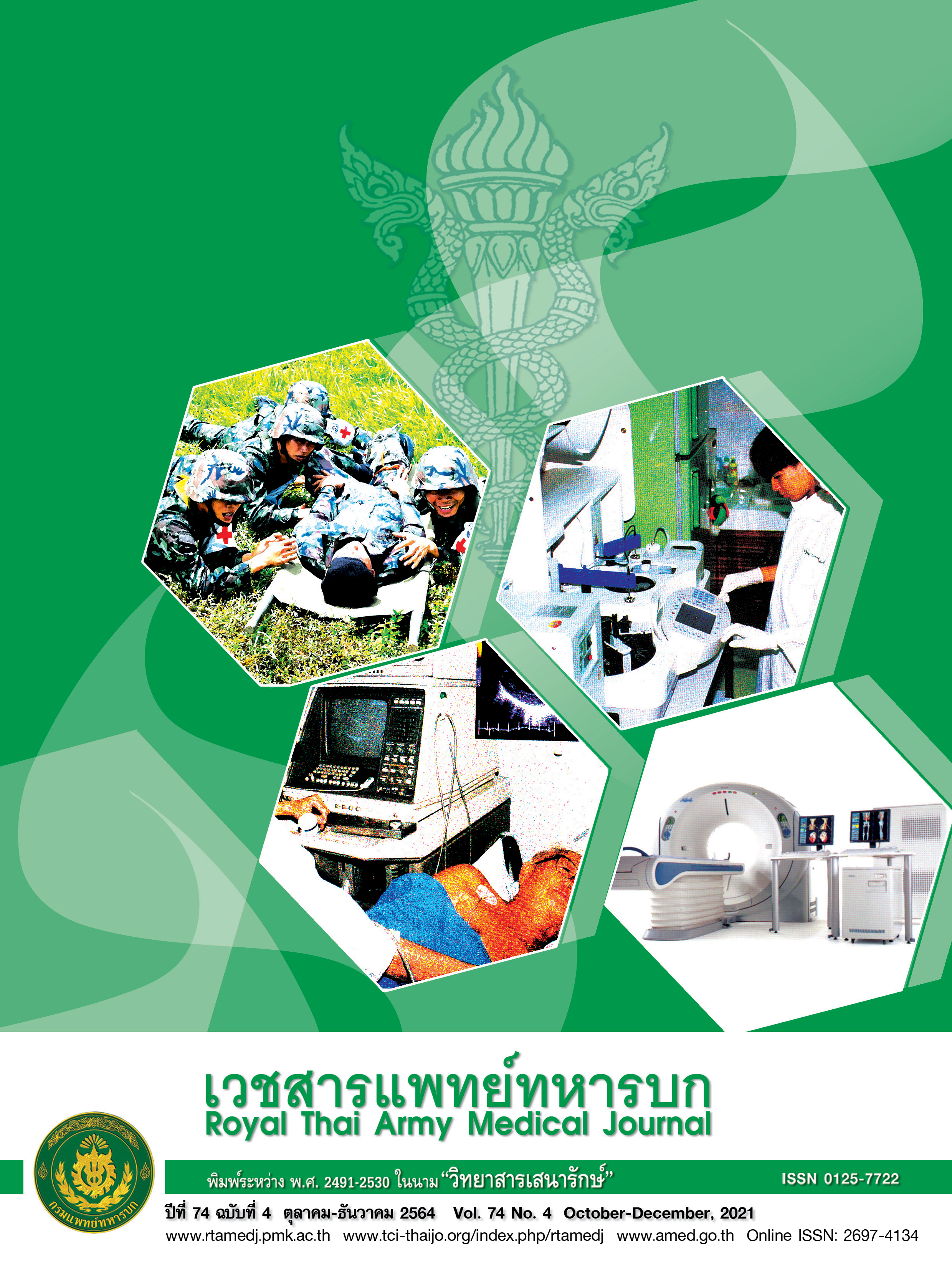Predictive Factors Associated with Positive Frozen Section Margins in patient with Early Breast Cancer Underwent Breast Conservative Surgery
Main Article Content
บทคัดย่อ
บทคัดย่อ
บทนำ มะเร็งเต้านมระยะแรกที่รักษาโดยการผ่าตัดแบบสงวนเต้านม การให้ขอบเขตของก้อนปลอดจากมะเร็ง เป็นหลักเพราะเป็นปัจจัยสำคัญที่ส่งผลต่อการเกิดเป็นซ้ำ ในปัจจุบันจะใช้การตรวจชิ้นเนื้อระหว่างผ่าตัดเพื่อระบุขอบเขตของมะเร็งว่าปลอดจากมะเร็ง เพื่อช่วยลดอัตราการผ่าตัดซ้ำ วัตถุประสงค์เพื่อหาปัจจัยทำนายที่มีผลต่อการตรวจพบ Positive margin จากการตรวจชิ้นเนื้อระหว่างผ่าตัดในการผ่าตัดแบบเก็บเต้านมในมะเร็งเต้านมระยะแรก วิธีการศึกษา เป็นการเก็บข้อมูลย้อนหลังในผู้ป่วยที่ได้รับการผ่าตัดแบบเก็บเต้านมในมะเร็งเต้านมระยะแรกที่เข้ารับการรักษาที่โรงพยาบาลพระมงกุฎเกล้า ตั้งแต่วันที่ 31 สิงหาคม 2557 – 31 สิงหาคม 2562 โดยวิเคราะห์ขอบเขตของก้อนโดยมีคำจำกัดความของ ขอบเขตปลอดมะเร็งคือไม่มีจุดของมะเร็งที่เห็นจากกล้องจุลทรรศน์ที่ขอบทุกด้านของชิ้นเนื้อ ส่วนขอบเขตพบมะเร็งคือพบจุดของมะเร็งที่เห็นจากกล้องจุลทรรศน์ในชิ้นเนื้อหรือพบจุดของมะเร็งบนของของหมึกที่พยาธิแพทย์ทำการแต้มสีไว้ นำผลที่ได้มาวิเคราะห์ทั้งแบบตัวแปรเดียวและหลายตัวแปร ผลการวิจัย พบผู้ป่วย 60 รายที่มีขอบเขตพบมะเร็ง (ร้อยละ 26.7) ในจำนวนนี้ 56 รายได้รับการผ่าตัดซ้ำอย่างน้อย 1 ครั้งเพื่อให้ขอบเขตปลอดมะเร็ง และมี 3 รายที่ต้องตัดเต้านมออกทั้งหมด ขอบเขตด้านหลังจะพบมะเร็งมากที่สุด (ร้อยละ 35) รองลงมาคือด้านในและด้านล่างตามลำดับ การตรวจชิ้นเนื้อระหว่างผ่าตัดมีความไวร้อยละ 87.7 และความจำเพาะร้อยละ 98.1 ปัจจัยทำนายขอบเขตพบมะเร็งได้แก่เนื้องอกขนาดมากกว่า 2 ซม., พบมีแคลเซี่ยมจากการตรวจทางรังสี, มี DCIS component, และ Ki67 มากกว่าร้อยละ 20 สรุปการตรวจชิ้นเนื้อระหว่างผ่าตัดเพื่อระบุขอบเขตของมะเร็งว่าปลอดจากมะเร็งในการผ่าตัดแบบสงวนเต้านมมีประโยชน์ให้ขอบเขตก้อนปลอดมะเร็งและป้องกันการผ่าตัดซ้ำ โดยเฉพาะในผู้ป่วยที่มีก้อนขนาดใหญ่ มีแคลเซี่ยมเกาะ, มี DCIS เป็นส่วนประกอบและมี Ki67 สูง
Downloads
Article Details
บทความในวารสารนี้อยู่ภายใต้ลิขสิทธิ์ของ กรมแพทย์ทหารบก และเผยแพร่ภายใต้สัญญาอนุญาต Creative Commons Attribution-NonCommercial-NoDerivatives 4.0 International (CC BY-NC-ND 4.0)
ท่านสามารถอ่านและใช้งานเพื่อวัตถุประสงค์ทางการศึกษา และทางวิชาการ เช่น การสอน การวิจัย หรือการอ้างอิง โดยต้องให้เครดิตอย่างเหมาะสมแก่ผู้เขียนและวารสาร
ห้ามใช้หรือแก้ไขบทความโดยไม่ได้รับอนุญาต
ข้อความที่ปรากฏในบทความเป็นความคิดเห็นของผู้เขียนเท่านั้น
ผู้เขียนเป็นผู้รับผิดชอบต่อเนื้อหาและความถูกต้องของบทความของตนอย่างเต็มที่
การนำบทความไปเผยแพร่ซ้ำในรูปแบบสาธารณะอื่นใด ต้องได้รับอนุญาตจากวารสาร
เอกสารอ้างอิง
2. Jorns M, Visscher D, Sabel M, Bresel M, Healy P, Daignaut S, et al. Intraoperative frozen section analysis of margins in breast conserving surgery significantly de-creases reoperative rates: one-year experience at an ambulatory surgical center. Am J Clin Pathol 2012;138(5):657–69.
3. Osako T, Nishimura R, Nishiyama Y, Okumura Y, Tashima R, Nakano M, et al. Efficacy of intraoperative entire-circumferential frozen section analysis of lumpectomy margins during breast-conserving surgery for breast cancer. Int J Clin Oncol. 2015;20(6):1093-101.
4. Luu HH, Otis CN, Reed WP Jr, Garb JL, Frank JL. The unsatisfactory margin in breast cancer surgery. Am J Surg. 1999;178(5):362-6.
5. Aziz D, Rawlinson E, Narod SA, Sun P, Lickley HL, McCready DR, et al. The role of reexcision for positive margins in optimizing local disease control after breast-conserving surgery for cancer. Breast J. 2006;12(4):331-7.
6. Camp ER, Priscilla F, Jeffrey S, Christopher G, D Scott L, Nancy P, et al. Minimizing local recurrence after breast conserving therapy using intraoperative shaved margins to determine pathologic tumor clearance. J Am Coll Surg. 2005; 201(6):855–861.
7. Fukamachi K, Ishida T, Usami S, Takeda M, Watanabe M, Sasano H, et al. Total-circumference intraoperative frozen section analysis reduces margin-positive rate in breast-conservation surgery. Jpn J ClinOncol. 2010; 40(6):513–520.
8. Ko S, Chun YK, Kang SS, Hur MH. The usefulness of intraoperative circumferential frozen-section analysis of lumpectomy margin in breast conserving surgery. J Breast Cancer 2017;20(2);176-182.
9. Miller AR, Brandao G, Prihoda TJ, Hill C, Cruz AB Jr, Yeh IT. Positive margins following surgical resection of breast carcinoma: analysis of pathologic correlates. J Surg Oncol. 2004;86(3):134-40.
10. Singletary SE. Surgical margins in patients with early-stage breast cancer treated with breast conservation therapy. Am J Surg. 2002;184(5):383-93.
11. Cendán JC, Coco D, Copeland EM 3rd. Accuracy of intraoperative frozen-section analysis of breast cancer lumpectomy-bed margins. J Am Coll Surg. 2005;201(2):194-8.
12. Olson TP, Harter J, Muñoz A, Mahvi DM, Breslin T. Frozen section analysis for intraoperative margin assessment during breast-conserving surgery results in low rates of re-excision and local recurrence. Ann Surg Oncol. 2007;14(10):2953-60.
13. Weber WP, Engelberger S, Viehl CT, Zanetti-Dallenbach R, Kuster S, Dirnhofer S, et al. Accuracy of frozen section analysis versus specimen radiography during breast-conserving surgery for nonpalpable lesions. World J Surg. 2008;32(12):2599-606.
14. Borger J, Kemperman H, Hart A, Peterse H, van Dongen J, Bartelink H. Risk factors in breast-conservation therapy. J Clin Oncol. 1994;12(4):653-60.
15. Horiguchi J, Iino Y, Takei H, Maemura M, Yokoe T, Niibe H, et al. Surgical margin and breast recurrence after breast-conserving therapy. Oncol Rep. 1999;6(1):135-8.
16. Obedian E, Haffty BG. Negative margin status improves local control in conservatively managed breast cancer patients. Cancer J Sci Am. 2000;6(1):28-33.
17. Peterson ME, Schultz DJ, Reynolds C, Solin LJ. Outcomes in breast cancer patients relative to margin status after treatment with breast-conserving surgery and radiation therapy: the University of Pennsylvania experience. Int J Radiat Oncol Biol Phys. 1999;43(5):1029-35.
18. Park CC, Mitsumori M, Nixon A, Recht A, Connolly J, Gelman R, et al. Outcome at 8 years after breast-conserving surgery and radiation therapy for invasive breast cancer: influence of margin status and systemic therapy on local recurrence. J Clin Oncol. 2000;18(8):1668-75.
19. Tartter PI, Kaplan J, Bleiweiss I, Gajdos C, Kong A, Ahmed S, et al. Lumpectomy margins, reexcision, and local recurrence of breast cancer. Am J Surg. 2000;179(2):81-5.
20. Ikeda T, Enomoto K, Wada K, Takeshima K, Yoneyama K, Furukawa J, et al. Frozen-section-guided breast-conserving surgery: implications of diagnosis by frozen section as a guide to determining the extent of resection. Surg Today. 1997;27(3):207-12.


